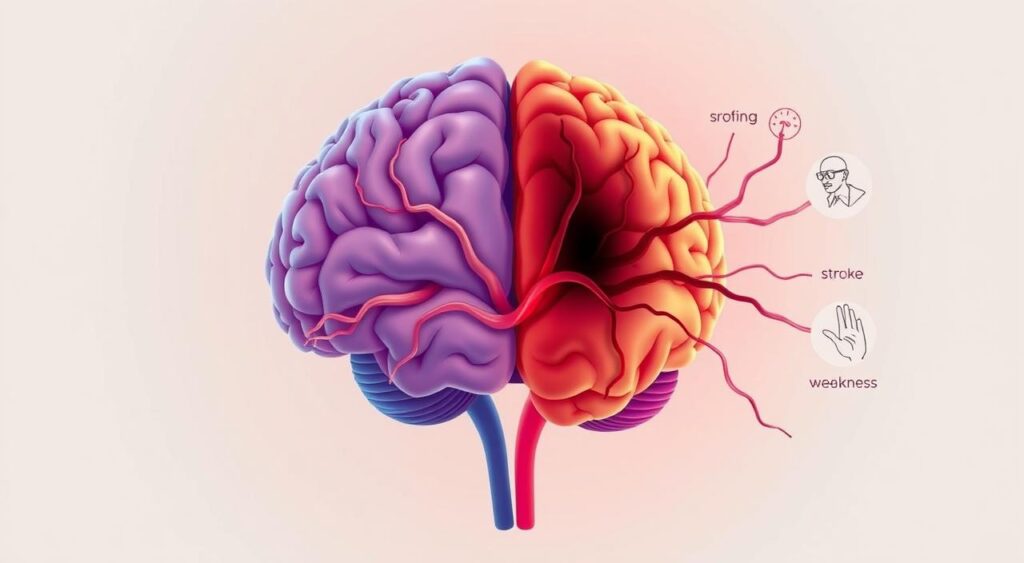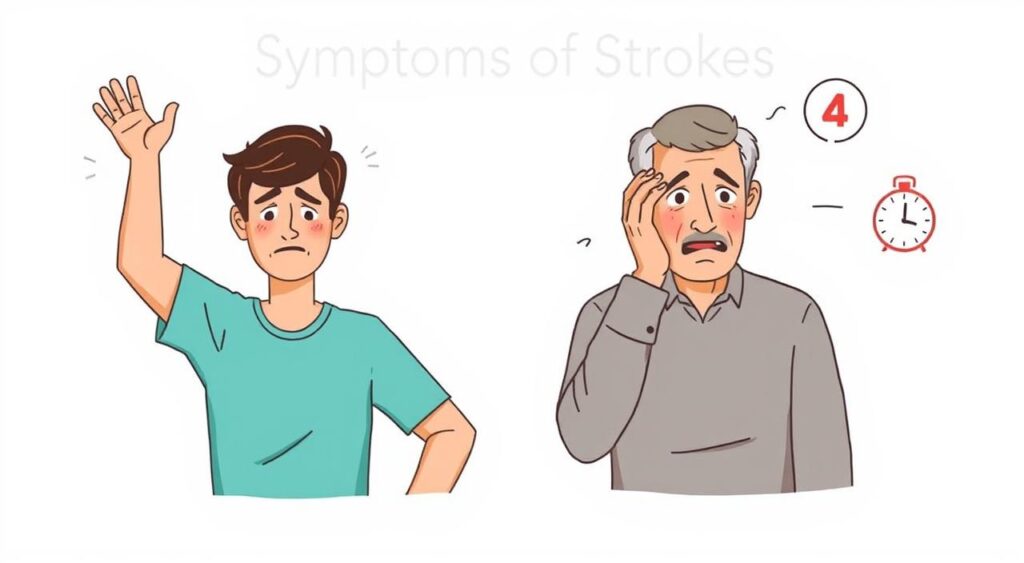Every year, more people face cerebrovascular accidents, or strokes. This condition is a big health problem. Knowing the signs of a stroke and acting fast is key to better outcomes. It’s important to learn about cerebrovascular accidents and strokes.

It’s crucial to understand cerebrovascular accidents and strokes to prevent and manage them. Strokes can deeply affect people and their families. By learning about these conditions, we can lower our risk and know how to act if a stroke happens.
Key Takeaways
- Cerebrovascular accidents, or strokes, affect more people .
- Recognizing stroke symptoms and responding quickly is critical for improving outcomes.
- Education and awareness are key to preventing and managing cerebrovascular accidents and strokes.
- Understanding the risk factors and causes of strokes can help individuals take proactive steps to reduce their risk.
- Prompt medical attention is essential for effective stroke treatment and management.
- Cerebrovascular accidents and strokes can have a significant impact on individuals and their families.
Understanding Cerebrovascular Accidents (Strokes)
A cerebrovascular disease, like a brain attack, happens when the brain’s blood supply stops. This causes damage to brain tissue. It’s vital to know about cerebrovascular accidents to understand their health impact.
The effects of a brain attack can be severe. Temporary or permanent damage to brain tissue can happen. Symptoms include numbness, weakness, and trouble with speech and coordination. The damage’s severity depends on where and how much brain tissue is affected.
Definition and Basic Concepts
A cerebrovascular accident, or stroke, is a medical emergency. The brain needs a steady supply of oxygen and nutrients to work right. When this supply stops, brain cells can die, causing cognitive and physical problems.
How Strokes Affect the Brain
Strokes can have a big impact on the brain.
- Cognitive impairment
- Physical disability
- Emotional changes
It’s important to know the warning signs of a brain attack. Seeking medical help quickly can help reduce damage.
Impact on Public Health
Cerebrovascular disease is a big public health issue, affecting millions globally. The cost of strokes is high, with big expenses for medical care, rehabilitation, and lost work time. It’s key to spread the word about brain attack risks and the need for prevention and early action.
| Type of Stroke | Description |
|---|---|
| Ischemic Stroke | Caused by a blockage in the blood vessels |
| Hemorrhagic Stroke | Caused by a rupture of the blood vessels |
Types of Strokes and Their Mechanisms
Strokes are divided into three main types: ischemic, hemorrhagic, and transient ischemic attack. An ischemic stroke happens when a brain blood vessel gets blocked. This reduces blood and oxygen flow to the brain. It’s the most common type, making up about 87% of all strokes.
A hemorrhagic stroke occurs when a weak blood vessel in the brain bursts. This causes bleeding in the brain. It’s less common but more deadly, with a higher death rate than ischemic strokes. A transient ischemic attack, or mini-stroke, is a brief blockage of brain blood flow. It’s often a warning sign for a future stroke.
It’s key to understand how these strokes work to diagnose, treat, and prevent them. Ischemic strokes can be either thrombotic or embolic. Thrombotic strokes are when a blood clot forms in a brain vessel. Embolic strokes are when a clot forms elsewhere and travels to the brain.
- Ischemic stroke: blockage of a blood vessel in the brain
- Hemorrhagic stroke: rupture of a weakened blood vessel in the brain
- Transient ischemic attack: temporary disruption of blood flow to the brain
Knowing the differences and how they happen can help people lower their risk. It also helps them react quickly if a stroke happens.
Risk Factors and Common Causes
Knowing the risk factors for cerebrovascular accidents is key to preventing strokes. Some factors can raise a person’s stroke risk. Being aware of these can help lower the risk. Strokes, or cerebrovascular accidents, come from both things we can and can’t change.
Modifiable Risk Factors
Things we can change include high blood pressure, smoking, and obesity. We can manage these with lifestyle changes and medical help. For example, eating well and exercising can lower blood pressure and stroke risk.
Non-modifiable Risk Factors
Things we can’t change are age, gender, and family history. Yet, knowing these can help us take steps to prevent strokes. For instance, those with a family history of strokes can work with doctors to lower their risk.
Understanding cerebrovascular accident risk factors helps us prevent strokes. We can change our lifestyle, like quitting smoking and exercising. We also need to work with doctors to manage risk factors.
| Risk Factor | Description |
|---|---|
| High Blood Pressure | Can damage blood vessels and increase stroke risk |
| Smoking | Can damage blood vessels and increase stroke risk |
| Obesity | Can increase blood pressure and stroke risk |
By knowing these risk factors and taking steps to prevent strokes, we can lower our risk of cerebrovascular accidents.
Recognizing the Warning Signs
Stroke symptoms can vary from person to person. It’s key to know the common signs to act fast. Acting quickly can greatly improve recovery chances and lessen long-term damage risks. Common symptoms include sudden weakness or numbness in the face, arm, or leg, trouble speaking or understanding speech, and sudden blurred vision or loss of vision in one eye.
People having a stroke might also show less common symptoms like sudden severe headache, dizziness, or loss of balance. Remember, symptoms can differ and may be more subtle in some, like women or younger adults. If you or someone you know shows these signs, call for emergency medical help right away.

Knowing the warning signs and acting fast can greatly help recovery. By recognizing symptoms and getting medical help quickly, people can get timely treatment. This can lessen the stroke’s impact.
Emergency Response and Immediate Actions
When a stroke is suspected, every minute is crucial. Knowing the signs and acting fast can greatly improve outcomes. It’s important to act quickly and follow established protocols.
The FAST method is a key tool for recognizing stroke symptoms. It checks for facial drooping, arm weakness, and speech issues. If you notice these signs, call 911 right away and get medical help.
Using the FAST Method
The FAST method is simple and effective for spotting stroke symptoms. It looks for:
- Facial drooping: Ask the person to smile and see if one side of their face droops.
- Arm weakness: Have them raise both arms and check if one is weak or numb.
- Speech difficulties: Ask them to repeat a simple sentence and see if their speech is slurred or hard to understand.
First Aid Measures
While waiting for help, there are steps you can take. These include:
- Keeping the person calm and comfortable.
- Loosening any tight clothing around their neck.
- Not giving them anything to eat or drink.
Effective stroke treatment needs quick medical help. By recognizing symptoms and acting fast, you can help ensure timely and effective strokes treatment.
Remember, with strokes, every minute is critical. Quick action and following protocols can lead to the best outcomes for those affected.
| Stroke Symptom | What to Do |
|---|---|
| Facial drooping | Call 911 immediately |
| Arm weakness | Seek medical attention |
| Speech difficulties | Follow the FAST method |
Diagnostic Procedures and Tests
When someone shows signs of a cerebrovascular disease, like a stroke, quick action is key. Doctors need to run tests to confirm the diagnosis and understand how severe it is. These tests help doctors see how much damage there is and plan the best treatment.
Some common tests for cerebrovascular disease include:
- CT scans: to see the brain and find any damage or blockages
- MRIs: to get detailed images of the brain and its blood vessels
- Angiograms: to look at the blood vessels and find any blockages or issues
- Echocardiograms: to check the heart’s function and find any blood clot sources
These tests are vital for diagnosing cerebrovascular disease and finding the right treatment. With these tests, doctors can give patients the care they need quickly. This helps patients recover better and reduces the risk of lasting damage.
Doctors also use other tools, like blood tests and physical examinations, to learn more about the patient. By combining all the test results, doctors can fully understand the patient’s condition. Then, they can create a treatment plan that fits the patient’s needs.
Treatment Options and Medical Interventions
Timely and effective treatments are key for stroke care. The main goal is to get blood flowing to the brain again. This helps prevent more damage. Various emergency treatments, long-term plans, and rehabilitation options are available.
Emergency treatments include thrombolytic therapy and mechanical thrombectomy. These methods dissolve or remove blood clots. For hemorrhagic strokes, surgery might be needed to fix damaged blood vessels.
Emergency Treatments
- Thrombolytic therapy: medications to dissolve blood clots
- Mechanical thrombectomy: procedure to remove blood clots from the brain
- Surgical options: repair damaged blood vessels for hemorrhagic strokes
Long-term Treatment Plans
Long-term plans aim to prevent future strokes and manage health conditions. This includes taking medications for blood pressure, cholesterol, and sugar. A healthy diet and regular exercise are also part of the plan.
Rehabilitation Options
Rehabilitation helps stroke patients regain lost functions. It includes physical, occupational, and speech therapy. These therapies are customized for each patient. A team of healthcare professionals, like neurologists and physical therapists, work together.
| Treatment Option | Description |
|---|---|
| Thrombolytic therapy | Medications to dissolve blood clots |
| Mechanical thrombectomy | Procedure to remove blood clots from the brain |
| Rehabilitation therapy | Physical, occupational, and speech therapy to regain lost functions |
Recovery and Rehabilitation Process
Recovering from a brain attack is a long and tough journey. Patients may deal with physical, cognitive, and emotional issues. Physical therapy helps them regain strength and mobility. Occupational therapy makes daily tasks easier.
A supportive environment is key for recovery. Family and caregivers offer emotional support and encouragement. Speech therapy helps patients overcome communication problems and regain independence.

Recovering from a brain attack is a long-term process. Improvements can take months or even years. It’s important for patients to stay positive and celebrate small victories.
With the right therapy and support, people can overcome brain attack challenges. They can regain their quality of life.
- Physical therapy to regain mobility and strength
- Occupational therapy to perform daily activities
- Speech therapy to overcome communication barriers
Understanding the recovery and rehabilitation process helps individuals face brain attack challenges. It leads to a successful recovery.
Prevention Strategies and Lifestyle Modifications
Living a healthy lifestyle is key for stroke prevention. Making smart choices can lower your stroke risk. A balanced diet, regular exercise, and good medical care are vital.
Some foods can help prevent strokes. Berries and leafy greens are full of antioxidants, protecting cells. Omega-3 rich foods like salmon and walnuts also reduce inflammation.
Dietary Recommendations
- Eat a variety of fruits and vegetables
- Incorporate whole grains into your diet
- Choose lean protein sources, such as poultry and fish
Regular exercise is also crucial for stroke prevention. Aim for 30 minutes of moderate activity daily. This can be brisk walking, cycling, or swimming. A healthy diet and exercise together can greatly lower stroke risk.
Exercise Guidelines
- Start with short sessions and gradually increase duration and intensity
- Incorporate strength training exercises to improve overall health
- Find activities that you enjoy and make them a part of your daily routine
By adopting these lifestyle changes and consulting with your doctor, you can manage your stroke prevention plan. This can significantly reduce your stroke risk.
Living with Post-Stroke Effects
After a stroke, people face big challenges in their daily lives. These can include physical disabilities, cognitive issues, and emotional changes. It’s important to know that adjusting to these changes takes time, patience, and support.
Common stroke effects include weakness or paralysis in limbs, trouble with speech and communication, and cognitive problems like memory loss. To cope, people can make home changes and use assistive technologies like wheelchairs and communication aids.
Here are some strategies for daily life after a stroke:
- Break tasks into smaller steps
- Use calendars and reminders to stay organized
- Try relaxation techniques like deep breathing and meditation to handle stress
Having a strong support system is key. This includes healthcare professionals, family, and friends. Support groups offer a sense of community and connection with others facing similar challenges. Together, people can find ways to live with stroke effects and improve their quality of life.
With the right support and approach, people can overcome stroke challenges and live a fulfilling life. Remember, every stroke experience is unique. It’s vital to tailor strategies to meet each person’s specific needs and goals.
| Strategy | Benefits |
|---|---|
| Home modifications | Improved safety and mobility |
| Assistive technologies | Increased independence and communication |
| Support groups | Emotional support and connection with others |
Conclusion: Taking Control of Stroke Prevention and Management
As we wrap up this guide on cerebrovascular accidents (strokes), it’s clear that preventing and managing strokes is key to our health. Knowing the different types of strokes, their causes, and the need for quick action helps us take steps to reduce their impact.
Spotting stroke warning signs early and acting fast is crucial. It helps improve outcomes and lessens long-term problems. Making healthy lifestyle choices, like eating right, exercising, and managing health issues, can also lower our stroke risk.
Strokes can change lives, but medical progress and rehab offer hope. By staying informed and involved in our healthcare, we can manage and prevent strokes. This improves our lives and those of our loved ones. Let’s use what we’ve learned to spread the word and make stroke prevention a priority in our communities.
FAQ
Q: What is a cerebrovascular accident (stroke)?
A: A stroke is a serious medical emergency. It happens when blood flow to the brain is cut off or a blood vessel bursts. This can damage brain tissue and be very dangerous.
Q: What are the different types of strokes?
A: There are three main types of strokes. Ischemic strokes happen when a blood vessel gets blocked. Hemorrhagic strokes occur when a blood vessel bursts. TIAs, or “mini-strokes,” are temporary blockages that don’t cause lasting damage.
Q: What are the risk factors for strokes?
A: Risk factors for strokes include things you can change and things you can’t. You can change high blood pressure, cholesterol, diabetes, smoking, obesity, and being inactive. Things you can’t change include age, gender, family history, and race.
Q: What are the warning signs of a stroke?
A: Warning signs of a stroke include sudden numbness or weakness. It can affect the face, arm, or leg on one side. Other signs are sudden confusion, trouble speaking or understanding, sudden vision problems, trouble walking, dizziness, and severe headache with no cause.
Q: What should I do if I suspect someone is having a stroke?
A: If you think someone is having a stroke, act F.A.S.T. Check if their face is drooping, ask them to raise both arms, and listen for slurred speech. If you see these signs, call 911 right away. Quick action can save a life.
Q: How are strokes treated?
A: Treatment for strokes depends on the type and how severe it is. For ischemic strokes, doctors might use clot-busting medications or mechanical thrombectomy. Hemorrhagic strokes might need surgery to stop bleeding. Long-term, doctors may prescribe medications and recommend therapy to help recovery.
Q: Can strokes be prevented?
A: Yes, many strokes can be prevented. By making healthy lifestyle choices and managing health conditions, you can lower your risk. Eating well, exercising regularly, controlling blood pressure and diabetes, and not smoking or drinking too much alcohol are key.
